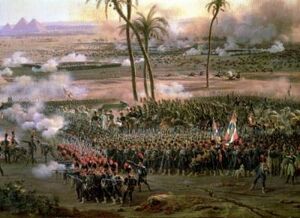1792-1796: War in France and the Lowlands[]
After the French Revolution succeeded in overthrowing Louis XVI and establishing the French Republic, the many nations of Europe united in the First Coalition to fight the revolutionaries and put the Bourbon's back on the French throne. The Holy Roman Empire, Prussia, and Britain led the charge by invading France through the north and th east, pushing deep into France, and leaving the fate of the Revolution in doubt. But finally on September 20, 1792, Charles Francois Dumouriez led 47,000 French to victory at Valmy to a decisive victory and created a stalemate in the east. As the stalemate was broken and Franc began to win many more victories, the Prussian and Holy Romans lost too many men and were forced to retreat, ending the invasion of France. Meanwhile, the British attempted an attack on southern France's ports, including Toulon, in an attempt to nulify the French Mediterranean Fleet. During the battle of Toulon, Napoleon Bonaparte at this point took the advantage of France's geographical position in Toulon, and fired his cannons on the British ships, which later retreated. Napoleon then took part in the land battle, which drove the invaders from the port, but also forced the French Mediterranean fleet to stay in port a few years. This battle launched the career of Napoleon Bonaparte, who was then promoted to Brigadier General, and brought him to the attention of the Parisian political elite.
The next phase of the war took place in the European Lowlands, which had occupied by the British and Prussians. The French fought in the Lowlands for four years, and the war there eventually stretched into the Rhineland even, and the over-extended invaders were forced to retreat from both fronts. The retreat led to France annexes much of the Rhineland and Belgium, and the Netherlands being reformed into the Batavian Republic, a French client state, the first of many.
1796-1797: War in Italy[]
With the war in the Rhineland and the Lowlands nearing its ends, Napoleon was transfered from Southern France to lead France's latest campaign in Italy. Although France was not facing defeat in the Rhineland, Napoleon was achieving total success in Italy, defeating Austria and Sardinia in the northwest, and forcing a peace upon Sardinia after capturing Milan. And then went on to finish off the Austrians in the Northeast, and then established a client state in northern Italy, the Cisalpine Republic.
After the multiple victories of France in this time, Spain signed a treaty, which also brought Spain onto the side of France, in return for territories in Italy, which would later be nullified in the First European Wars. Britain, as a result of this, withdrew all of its forces from Corsica, and began to put more fortifications in Gibraltar.
Napoleon captured Mantua, after a long siege, and with it 18,000 Austrians, and further moves by France forced the Austrians to sue for peace in April 1797. The Treaty of Campo Formio in October forced the Coalition to give control of the Lowlands to France, as well as of the Rhineland. The Republic of Venice was then also partitioned into two parts, part to France and part to Austria, ending the country's 1100 years of existence.
1798-1800: War in Egypt[]
The peace that had ended the first part of the French Revolutionary Wars was short lived, as the next year in 1798, the French were again at war with a new Coalition made up of Britain, Russia, and Austria. In 1798, Napoleon led his Armée d'Orient into Egypt in an attempt to overthrow the Mamluk and Ottoman rule in the area, as well as cut of British trade with India. Thirteen days after leaving for Egypt, Napoleon captured Alexandria and then moved south to capture the rest of Egypt. On July 21, 1798, after the Battle of the Pyramids allowed Napoleon to capture Cairo and forced the Ottomans and Mamelukes to retreat from Egypt into Syria. But ten days later, at the Battle of the Nile, Horatio Nelson and his British fleet of 15 ships defeated 17 French ships, resulting in Egypt being cut off from France and Napoleon then returned to France in August 1799, leaving his army behind, which would later be forced to surrender in 1800.
In November 1799, Napoleon led a coup d'etat and established a new French government with him as First Consul. The position in which he remained in until becoming Emperor in 1804, and establishing the French Empire.
1800-1802: War in the Rhineland and the Treaty of Amiens[]
The French invaded Bavaria in 1800 under General Moreau, after a short campaign, he fought the Austrians at Hohenlinden, winning a decisive victory on December 3, and forcing the Austrians to accept another peace. The Treaty of Luneville forced the Austrians to accept the Treaty of Campo Formio and was a another humiliating defeat of Austria. The British signed the Treaty of Amiens with France in 1802, which is accepted by historian as the transitional device between the French Revolutionary Wars and the First European War. Peace would be broken the next year, an event that forever plagued many of Europe's rulers after its results were shown.


